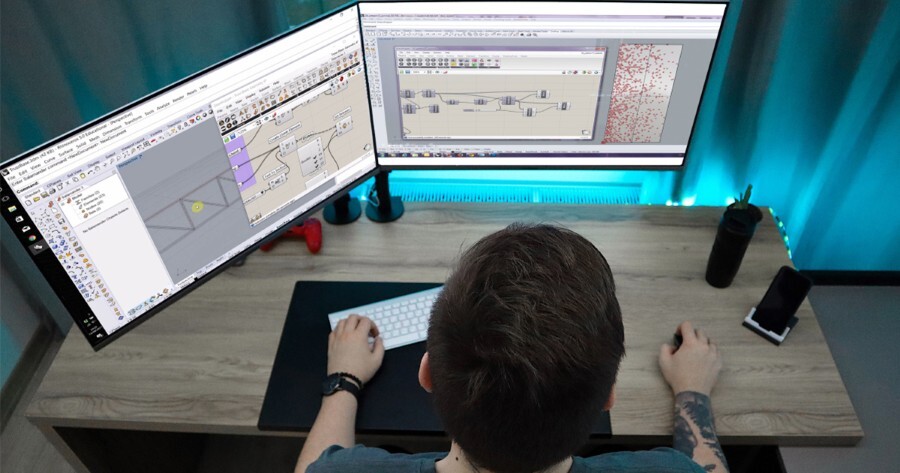
Optimization in computational design allows architects to explore hundreds of design variations efficiently. It helps achieve balanced outcomes between aesthetics, performance, and structure in the facade of buildings. The debate on Galapagos vs Wallacei often arises when designers look for the right tool to enhance their design workflows.
According to a McKinsey report, technology adoption and data-driven modeling can boost construction productivity by over 60%. This makes choosing the right optimization plugin crucial for accurate and efficient results. The guide explains what is Galapagos Grasshopper, what is Wallacei Grasshopper, how they compare, and when to use each for effective design facade building.
What is Galapagos?

Galapagos is a built-in optimization tool in Grasshopper that uses genetic algorithms to find the best solution among multiple possibilities. Anyone learning what is Galapagos Grasshopper will encounter it early because it’s intuitive and well-integrated into the Rhino–Grasshopper environment.
It works by simulating evolution: parameters are treated as “genes,” and the software iteratively evolves combinations until an optimal solution is found.
Galapagos is ideal for:
- Single-objective optimization problems.
- Form-finding tasks like minimizing surface area or maximizing daylight.
- Early-stage exploration of the facade of buildings.
The Galapagos plugin in Grasshopper offers simplicity and ease of setup. Users define inputs, connect a fitness goal, and allow the solver to iterate automatically. In many Galapagos for Grasshopper example cases, designers use it to optimize facade panels, adjust window openings, or balance shading performance.
Architects often start learning through a Galapagos grasshopper tutorial before advancing to more complex tools. While effective, Galapagos is best suited for smaller or straightforward projects with one main objective. It lacks the ability to handle multiple competing goals simultaneously, which is where Wallacei becomes valuable.
What is Wallacei?

The Wallacei plugin in Grasshopper is a more advanced evolutionary multi-objective optimization tool, developed to extend the capabilities of optimization beyond what Galapagos offers. While what is Wallacei Grasshopper may appear comparable at first, Wallacei distinguishes itself with enhanced analytical depth, robust constraint-handling mechanisms, and dynamic visualization tools.
Key features of Wallacei include:
- Multi-objective optimization support with Pareto front visualization (e.g., exploring trade-offs among multiple fitness goals).
- Automated constraint management (hard and soft constraints) so undesirable solutions can be filtered or penalized.
- Statistical analysis dashboards (violin plots, box plots, correlation charts) to understand population behavior and convergence.
- Sensitivity analysis and ranking of input variables to reveal which parameters influence outcomes most.
- Adaptive population control and stopping criteria to improve efficiency and avoid wasted cycles.
- Robust integration with Galapagos-like workflows, allowing users to use familiar parameter- objective paradigms with enhanced feedback.
Because of these enhanced features, Wallacei is highly effective for complex design workflows such as building massing in Wallacei Grasshopper and advanced facade optimization that involve balancing multiple conflicting objectives.
Comparison: Galapagos vs Wallacei
When analyzing Galapagos vs Wallacei, both tools share a goal optimization but differ in complexity, speed, and output analysis.
Galapagos is simple and faster to run. It is effective for single-objective optimization, making it ideal for beginners or for quick, conceptual studies. In contrast, Wallacei excels at multiobjective problems, enabling architects to manage several design goals at once.
Speed and ease of use: Galapagos operates efficiently for small datasets. Wallacei handles more data but takes longer due to the added computation and visualization processes.
Learning curve: Galapagos is straightforward for new users. Wallacei demands more understanding of optimization theory and settings configuration.
Visualization: Galapagos provides basic progress graphs. Wallacei offers detailed analytics that allow deeper exploration of solutions.
Pros and Cons:
|
Aspect |
Galapagos |
Wallacei |
|
Speed |
Fast for single objectives |
Slower, higher overhead |
|
Ease of setup |
Very intuitive |
Requires configuration |
|
Learning curve |
Gentle |
Steep needs optimization knowledge |
|
Visualization |
Basic fitness plots |
Advanced interactive analytics |
|
Ideal use |
Quick concept tests |
Complex, multiobjective projects |
|
Drawback |
Limited to a single objective |
Computational cost, complexity |
Both tools can work in sequence. Many designers use Galapagos first to narrow down parameters, then switch to Wallacei for comprehensive optimization and analysis. Together, they provide a complete workflow for parametric optimization in the facade of buildings.
When to Use Which Optimizer?

Choosing between Galapagos Vs Wallacei depends on goals, dataset size, and the need for trade-off analysis. Follow this guidance to match each optimizer to your design intent.
Use Galapagos when:
- The project has one dominant optimization target.
- You need rapid iterations during early conceptual design.
- When developing a Galapagos grasshopper tutorial or working on a prototype, it serves best for testing single-objective optimization concepts..
Use Wallacei when:
- Multiple, conflicting objectives must be balanced.
- Visual analytics and Pareto exploration are required.
- You are optimizing building massing in Wallacei grasshopper or complex facade performance.
- You want to preserve results for post-analysis and review.
Real-world examples:
- Al Bahar Towers (Abu Dhabi) – The adaptive mashrabiya façade uses parametric control and performance-driven design to reduce solar gain. Teams relied on iterative computational optimization to refine kinetic shading geometry.
- ICD/ITKE Research Pavilions (Stuttgart) – These pavilions showcase form-finding and structural optimization through evolutionary algorithms, mirroring workflows in Wallacei.
- Fondation Louis Vuitton (Paris) – Gehry’s curved glass sails used parametric optimization to align geometry, fabrication limits, and cost.
Choose Galapagos for fast, single-goal exploration and Wallacei for nuanced, multi-criteria decision-making.
Learn Galapagos and Wallacei for Facade & Parametric Optimization
Mastering Galapagos and Wallacei can transform how designers approach performance-driven architecture. To gain practical expertise, Novatr’s Master Computational Design Course offers structured, hands-on learning tailored to real architectural workflows.
Here's what you'll learn in our Computational Design Course:
- 5 powerful industry tools — Grasshopper, Rhino 3D, Flux.ai, ComfyUI, and D5 Render.
- Master popular plugins like Paneling Tools, DeCoding Spaces, Anemone, Galapagos, Wallacei, LunchBox, Open nest and Horster Animation to create smarter, faster design workflows.
- Understand how to build parametric and generative design workflows used by top global firms.
- Learn how to automate repetitive design tasks, explore AI-driven creativity, and produce high-quality renders for presentations.
- Develop a professional computational design portfolio showcasing your project-based learning.
Earn dual certification from Novatr and NSDC (National Skill Development Corporation) upon completion, and step confidently into the world of future-ready architecture and design.
Disclaimer - Course details, including curriculum, duration, fees, and related information, are for informational purposes only and may change at the company’s discretion without prior notice. Please visit the official course page or contact our admissions team for the latest updates.
Conclusion
Knowing the difference between Galapagos vs Wallacei helps designers choose the right optimizer for each stage of a project. Galapagos is quick, simple, and ideal for single-objective studies, while Wallacei supports advanced multiobjective workflows that balance performance criteria.
For architects involved in designing facade buildings or environmental modeling, both tools are invaluable. Learning them through the Master Computational Design course by Novatr builds the foundation for data-driven design decisions that lead to smarter, high-performance architecture.
Visit our resource page to learn more about the program and receive expert guidance on advancing your career.
Was this content helpful to you



.jpg)



